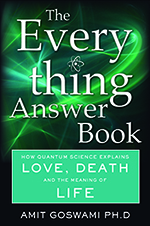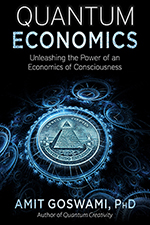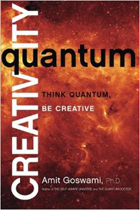A Brief History of Quantum Activism
By Amit Goswami, Ph. D.
Quantum physics is quite old now; almost a hundred years have passed since its complete mathematical formulation. It has been verified by myriad experiments; technologies work when based on quantum ideas; and our society has begun to use the word “quantum” profusely but often with misconception. The bad news is that with nearly a hundred years of quantum physics, the quantum worldview has still not been accepted by the scientific establishment and the media blindly follows the lead of establishment science and keeps spreading the archaic Newtonian worldview; consequently, the quantum worldview has not penetrated the public mind. The good news is that starting with the 1990s, the quantum worldview, thanks to the efforts of an avant-garde group of renegade scientists including myself, has come to full blossom and has given birth to an all inclusive new paradigm of science. We also have a grass roots movement—quantum activism—in place designed to dislodge the stranglehold of the Newtonian worldview on the scientific establishment and the media by directly appealing to people.
Part of the mischief rests with circumstances. From the beginning, there were quantum paradoxes from the point of view of the philosophy of the then (and still) prevalent Newtonian paradigm—officially called scientific materialism—everything is phenomenon of matter, material movement in space and time, caused by material interaction. It turns out that these paradoxes were not resolved and settled via experimental data in favor of the quantum worldview until the 1980s and ‘90s. The delay was mostly due to World War II and the shift afterwards of the hub of physics from a philosophy-oriented Europe to practical-minded America. In the meantime, scientific materialism became entrenched. Before the fifties, its arena was mainly physics and chemistry—the science of inanimate objects. After the fifties, the same philosophy began to dominate biology (biology became chemistry) and the health sciences (medicine became machine medicine), and eventually psychology (psychology became cognitive neuroscience).
The second party to the mischief was the inadvertent enthusiasm of well-meaning scientists to close the matter of understanding quantum physics as quickly as possible. So, a stopgap compromise was made called famously (or should I say notoriously?) The Copenhagen Interpretation pioneered by the famous and amicable Niels Bohr whom every physicist including this author worshipped while he was alive.
The centerpiece of the Copenhagen Interpretation is called the complementarity principle and in its most popularized form it is wrong, both theoretically and experimentally. Quantum mathematics says unequivocally that quantum objects are waves, but of course, experiments say that they are also particles. How can the same object be both wave (stuff that spreads out) and particle (stuff that travels in defined trajectories)? The popular form of the complementarity principle resolves this wave-particle duality paradox with this statement: quantum objects are both waves and particles; however, the wave aspect is revealed in wave-measuring experiments, and the particle aspect is revealed in particle-measuring experiments. Both aspects never show up in the same experiment and are thus complementary.
The correct answer to the paradox of wave-particle duality, theoretically and experimentally, is this: quantum objects are waves of possibility residing in a domain of reality outside of space and time called the domain of potentiality; whenever we measure them, they reveal themselves as particles in space and time. Both the wave and the particle nature can be detected (the wave nature always indirectly) in the same single experiment. Suffice it to say, the popularized version of the complementarity principle, creating the impression that the wave and particle aspect are both aspects of the object in space and time, misled an entire generation or two of physicists to close their minds against the really radical elements of quantum physics—that quantum physics insists on a two-level reality not the one space-time reality of Newtonian physics and scientific materialism. And that quantum physics cannot possibly be made paradox-free without explicitly invoking consciousness into physics.
But of course, it was the movement of consciousness that kept the paradoxes alive, not in the mainstream, but in a cultish sort of way. In the 1980s, an experiment by Alain Aspect and his collaborators resolved the two domains or one domain of reality? issue by discovering the signature of the domain of potentiality: In that domain, no signal is needed for communication; everything is instantly interconnected. In contrast, in space and time, signals, always moving with a speed no greater than the speed of light, mediate communication always taking a finite time.
What does it mean to say that the domain of potentiality is all instantly interconnected? Simply this: the stuff of this domain is one entity or whatever you call it. What should we call it? In 1989, I wrote a paper in a physics journal and followed that up with a popular book in 1993, The Self-Aware Universe with the paradox resolving proposition that the domain of potentiality is our consciousness, not in the form of ordinary ego-consciousness, but as a higher consciousness where we are all one. In manifest awareness, we become separate partly due to the necessity of distinction from the objects (the subject-object distinction) and partly due to our individual conditioning. I also proposed that this higher consciousness is causally empowered by the power of downward causation consisting of the capacity to choose among the many facets that a wave of possibility have. It is conscious choice that transforms waves of possibility into particles of actuality.
The philosopher/scientist Willis Harman, at the time the president of the Institute of Noetic Science, was very supportive of my work. He invited me to write a monograph on my research. The new research soon created a new science, science within consciousness; a term I later discovered was already in vogue thanks to Willis. The monograph by the same name was published by IONS in 1994.
Progress came rapidly. And always accompanied by strange coincidences of Jungian synchronicity. First, an old woman called me on a radio talk show with the question, “What happens when we die?” I didn’t know except cultural hearsay, so I kept quiet. Then a Theosophist—one of those believers of reincarnation—started taking a course from me on my book but ended up mostly talking about reincarnation. Soon after, I had a dream in which I woke up with the admonition “The Tibetan book of the dead is correct; it’s your job to prove it.” Finally, a graduate student of philosophy, a woman, called me and somehow convinced me to be her “therapist” to help her mourn for her boyfriend’s death and get over that. It is while conversing with this woman and trying to theorize about what does survive our death, I discovered a science of all our experiences—material sensing, vital feeling (of energy), mental thinking (of meaning) and supramental intuitions (of archetypes like love and truth). Based on this discovery, I developed a theory of survival after death and reincarnation. Soon after, I got a call from the author/editor Frank de Marco to write a book on my newest research which I did under the title Physics of the Soul.
My friend the biophysicist Beverly Rubik called me in 1998 asking me to contribute an article on my research on quantum physics and consciousness for an anthology she was completing. In 1999, I joined a group of thirty new paradigm thinkers to a conference with the Dalai Lama in Dharamsala, India. Big melodrama took place there. First the physicist Fred Alan Wolf and I had a verbal battle of egos: whose approach to the new paradigm is the correct one? Others joined in; the organizers complained to the Dalai Lama; and he laughed and laughed, “Scientists will be scientists.” After peace was thus established the Dalai Lama asked us to apply our new paradigm ideas to social issues. This caught my attention. When I returned to the States, I wrote the article for Beverly applying quantum physics to health and healing in which I developed a theory of what Deepak Chopra called quantum healing—spontaneous healing.
Around the same time, I was in Brazil and a young man asked me, “Are you good friends with Deepak Chopra?” Of course, that was natural both of us being of Indian origin and both of us being researchers of consciousness and all that. When I said “No,” this young man said, “I can correct that.” I don’t know what he did, but soon after I got an invitation to visit Deepak in San Diego, which I did. Deepak had just published a book Perfect Health on Ayurveda, an alternative healing system from India. He gave me a copy and wanted me to read it.
One thing led to another in this way and soon I ended up developing the scientific validity of an idea that physicians of alternative medicine have been using since millennia. Since we are more than our physical body, disease in our “subtle” bodies can also be responsible for physical disease, especially chronic disease. And then their healing is achieved not only by the cure of the physical symptoms, but healing the disease at the appropriate source.
Practitioners of health sciences, physical and mental, deal with actual human beings and machine medicine that began its dominance of how to heal human clients did not always meet with their enthusiastic approval. When I wrote a book The Quantum Doctor on integrating conventional “machine” medicine and alternative more human medicines, the quantum worldview began getting some traction among alternative medicine practitioners and even among avant-garde allopathic practitioners. Deepak was so enthusiastic about the book that he wrote the foreword to a later edition of the book.
But conventional medicine is based on the biology paradigm and to relax the strangle hold of scientific materialism on conventional medicine we have to go by the way of introducing consciousness in biology. I began that work in the 1990s and eventually in 2008 wrote a book Creative Evolution where I proposed a consciousness-based scientific theory of evolution that explains the fossil gaps and the biological arrow of time for evolution from simplicity to complexity, two important pieces of data that Darwinism and its offshoots cannot explain. In that book I integrated ideas of Sri Aurobindo and Teilhard de Chardin about the future of humanity within a scientific approach. I also integrated Rupert Sheldrake’s great ideas about morphogenetic fields (blueprints of biological form making) under the umbrella of science within consciousness.
The biology establishment, however, has been very resistant to quantum physics, although thanks to the empirical work on epigenetics and popular books by the biologists Bruce Lipton, Mae Wan Ho, and others the strangle hold is gradually losing its power.
Finally, in 2009, with the intention to accelerate the paradigm shift, I began a movement called quantum activism to popularize the quantum worldview via creating a group of people with the avowed motive of transforming themselves and their societies via practicing quantum principles. This has currently gained some attention in not only America, but in Brazil, Europe, Australia, and Japan.



